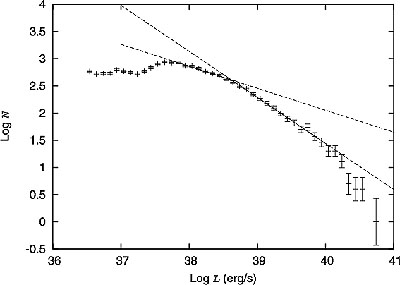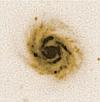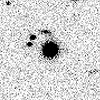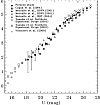The kinematics of diffuse ionized gas in the disk halo interface of NGC 891
The properties of the gas in halos of galaxies constrain global models of the interestellar medium. Kinematical information is of particular interest since it is a clue to the origin of the gas. From Fabry-Pérot TAURUS II observations of the kinematics
of the thick layer of the diffuse ionized gas in NGC 891, the rotation curve of the halo gas could be determined. Hα data cubes show much higher angular resolution than in the HI 21cm line. The velocity information of the diffuse ionized gas extracted from the data cube is compared to model distributions to constrain the distribution of the gas and in particular
the halo rotation curve. The astronomers find that the scale length of the Hα must be between 2.5 and 6.5 kpc. Furthermore they find evidence that the rotation curve above the plane rises less steeply than in the plane. This is all in agreement with the
velocitites measured in the HI (P. Kamphuis et al., 2007, "Kinematics of diffuse ionized gas in the disk halo interface of NGC 891 from Fabry-Pérot observations”, A&A, 468, 451).
The European Galactic Plane Surveys (EGAPS): IPHAS and UVEX
The European Galactic Plane Surveys (EGAPS) will for the first time ever map the complete galactic plane (10×360 degrees) down to 21st magnitude in u', g', r', i' and H-alpha and partly in He I 5875. It will complete a database of ~1 billion objects.
The aim of EGAPS is to study populations of short-lived stellar and binary phases in our Galaxy and combine these population studies with stellar and binary evolutionary codes to vastly improve our understanding of crucial phases of stellar evolution.
Target populations include Wolf-Rayet stars, planetary nebulae, white dwarfs (in binaries), cataclysmic variables and other mass-transferring binaries. EGAPS is using the INT+WFC on La Palma for the Northern Hemisphere and will use the VST+Omegacam in the
Southern Hemisphere. The Northern red survey (IPHAS, using r', i', and Halpha) started in 2003 and is complete. The northern blue survey (UVEX; u',g',r' and HeI) started in June 2006. Early results include the detection of a number of rare planetary nebulae,
cataclysmic variables, red-dwarf white dwarf binaries in clusters, a possible AM CVn candidate, and a deep photometric and spectroscopic investigation of the Cyg X region. EGAPS will revolutionize the field of galactic stellar astrophysics by completing the first ever fully
digital, multicolour deep survey of the Galactic Plane (Groot et al, 2006, "The European Galactic Plane Surveys: EGAPS", 26th meeting of the IAU, Joint Discussion, 13, 54.).
Kinematics of the ultracompact helium accretor AM Canum Venaticorum
AM Canum Venaticorum stars (AM CVn stars in short) are interacting binary stars: mass, mainly helium, is constantly flowing from one star to the other. What makes these objects special is their ultra-compact nature: they consist of two
degenerate, hydrogen-deficient stars, which makes that these binaries have extremely short orbital periods, from about one hour down to only a few minutes. Their ultracompact nature makes them the strongest
known sources of gravitational waves that can be detected with the future ESA/NASA cornerstone satellite mission LISA: the Laser Interferometer Space Antenna. Until now, only a few exotic AM CVn stars were known. Of crucial importance for expanding the known
population has been the advent of wide-field surveys such as the SDSS. In order to further improve the statistics of the sample, a number of dedicated wide-field sky surveys were designed and started, among them, IPHAS and
UVEX on the INT.In addition to population studies, some astronomers embarked on a project to study individual systems in detail using phase-resolved spectroscopic techniques. One of the main questions to address,
was how these binaries are formed. Theoretically, no fewer than three different formation channels have been proposed to contribute to the AM CVn population, but which of these channels actually produce AM CVn stars, and
in what numbers, has been a long-standing problem.
Using ISIS on the WHT, a team of astronomers was able to weigh the stars of AM CVn binary, and showed that they are more massive than previously throught. This has important consequences for their formation and evolution. In addition these observations allowed them, for the first time, to
accurately predict the gravitational-wave signatures of these binary stars and they have shown that the known short-period AM CVn stars are the first solid candidates for detection with a LISA-type instrument. These
stars will thus be of crucial importance to test and calibrate such a gravitational-wave detector, as well as directly test the predictions from General Relativity concerning the emission of gravitational waves from
binary stars (Roelofs et al., 2006, "Kinematics of the ultracompact helium accretor AM Canum Venaticorum", MNRAS, 371, 1231).
A composite H II region luminosity function in Halpha of unprecedented statistical weight
Statistical properties of H II region populations in disk galaxies yield important clues to the physics of massive star formation. Previous studies have shown that there might exist
a dual slope in the luminosity
function (LF) of H II regions, with a well defined break at specific luminosity, but the lack of a sufficient statistical base has prevented a conclusive result. One approach can be increasing
the statistical weight by deriving a general form of the LF from a sample of nearby spiral galaxies. For this reason, a team of astronomers obtained Halpha images of a sample of 53 spiral galaxies
using the JKT, and after photometric calibration, the galaxies were summed to form
a total LF comprising 17,797 HII regions. The new LF shows a clear two slope power law behaviour, with a significantly steeper slope for the high luminosity branch. This can be modelled
by assuming that the high luminosity regions are density bounded, though the scenario is complicated by the inhomogeneity of the ionized interstellar medium. The break, irrespective of its origin, is of potential use as a distance indicator for disc galaxies (Bradley et al., 2006, "A composite H II region luminosity function in H II of unprecedented statistical weight", A&A, 459, L13).
 |
LF made from the combined H II region catalogues of 53 nearby spiral galaxies. The large number of H II regions allows plotting the LF in steps of 0.1 dex. The best double-slope fit is indicated by the lines, where dashes show extrapolations beyond the range
over which the best fit has been made. (Extracted from Bradley et al., 2006, A&A, 459, L13) [ GIF ].
|
Massive star formation in the central regions of spiral galaxies
Enhanced nuclear activity in disk galaxies, in starburst or AGN form, appears to be an integral part of their evolution. Both forms of activity have been observed to co-exist and are a clear manifestation of the symbiotic evolution of galactic centres and their host galaxies. The observed tight correlation between the masses of the central black holes and the velocity dispersions in the surrounding bulges
provides the most direct evidence for this evolution and yields important clues on the dynamics, structure, and evolution of galaxies.
To initiate and to maintain the AGN or nuclear starburst activity, gas inflow must be stimulated from the disk to the central regions - a process which must be accompanied by a substantial loss of angular momentum in the gas.
Theoretically, this leads to the suggestion that gravitational torques acting through galactic bars or galaxy interactions are involved.
Massive star formation can be convincingly traced by the accompanying Halpha emission and is very easily observed with standard telescopes and cameras. Halpha is mainly produced in the H II regions surrounding massive B and O stars,
although shocks and non-stellar activity can also lead to Halpha emission. Using 73 images of galaxies obtained with the AUX camera of the WHT, a team of astronomers studied the morphology of the Halpha emission in the circumnuclear,
two kpc radius regions, as well as from the nucleus per se. The circumnuclear area was chosen is large enough to incorporate most nuclear rings. For most of the galaxies, no Halpha imaging was available and the spatial resolution was mostly below one second of arc. They confirmed
that late-type galaxies have a patchy circumnuclear appearance in Halpha, and that nuclear rings occur primarily in spiral types Sa-Sbc. They identified a number of previously unknown nuclear rings, and confirmed that nuclear rings are predominantly hosted by barred galaxies. Other than stimulating nuclear rings, bars do not influence the relative strength of the nuclear Halpha peak, nor the circumnuclear Halpha morphology. No significant
influence of the presence or absence of a close companion on the relative strength of the nuclear Halpha peak, nor on the Halpha morphology around the nucleus, was found (Knapen et al., 2006, "Massive star formation in the central regions of spiral galaxies
", A&A, 448, 489; Sarzi et al., 2007, "Star formation and stellar populations across nuclear rings in galaxies", MNRAS, 380, 949).
Discovery of a cluster of galaxies behind the Milky Way
Rich clusters of galaxies have been successfully used as tracers of large-scale structure formation and evolution, which has allowed setting constraints on various cosmological parameters. In the past, the majority of rich clusters was first identified in the optical
and later observed in X-rays. However, with the advent of large and deep X-ray surveys, X-ray observations have become one of the most useful techniques for discovering clusters of galaxies, especially for intermediate and high-redshift systems.
On the other hand, X-rays may also be useful for detecting clusters near the Galactic plane, where the increasing number of stars and extinction makes the optical identification of background galaxies difficult. Following this approach, astronomers reported
the discovery of Cl 2334+48, a rich cluster of galaxies in the Zone of Avoidance, identified in public images from the XMM-Newton archive, and followed up using optical images with the Wide Field Camera on the INT (Lopes de Oliviera et al., 2006, "Discovery of a cluster of galaxies behind the Milky Way: X-ray and optical observations", A&A, 459, 415).
The RApid Temporal Survey (RATS)
The intensity of stellar objects can vary on a wide range of time-scales, ranging from seconds to months to years. A large number of projects now exist whose aim is to detect such varying sources. The reasons for this are many,
but include the search for extrasolar planets and interacting binary stars. Most of these surveys are sensitive to time-scales longer than a day. It is only recently that such surveys have been sensitive to shorter term time-scales.
For instance, the Faint Sky Variability Survey on the INT has a large survey area and it was sensitive to variations only as short as ~24 min. In principle the SuperWasp project is sensitive to variations on time-scales as short as a few minutes. However, they are sensitive
to relatively bright objects, V~7–15 .
Why is it important that we extend the parameter search down to periods shorter than 10 min? Recently a new class of object has been discovered in which coherent intensity variations have been detected on time-scales of ~10 min or less. It is thought that
these systems are interacting white dwarf–white dwarf pairs which have no accretion disc, and the observed period represents the binary orbital period. As such, they are expected to be amongst the first sources to be detected using LISA,
the planned gravitational wave observatory.
These systems are at the short period end of the period distribution of white dwarf–white dwarf binaries, or AM CVn systems. For orbital periods less than 80 min, the secondary (mass-donating) star cannot be a main-sequence star.
Further, for periods shorter than 30 min, the secondary must be a helium white dwarf.
The aim of the Rapid Temporal Survey (RATS) is to discover objects whose optical intensity varies on time-scales of a few minutes to several hours. The prime aim is to discover interacting ultracompact binary systems – systems consisting of two degenerate
(or semidegenerate) stars orbiting around a common centre of gravity – with binary orbital periods less than ~70 min. The pilot survey set of data was obtained using the INT and the Wide Field Camera. It covered 3 deg2 and reached a depth of V~ 22.5.
Nearly 50 sources were found to show significant intensity variations, none were previously known variable objects. However, only four objects showed modulations which varied on periods of approximately 1 h or less being one a subdwarf B star and the
other three are likely to be SX Phe stars – dwarf δ Sct stars (Ramsay and Hakala, 2005, "RApid Temporal Survey (RATS) – I. Overview and first results", MNRAS, 360, 314;
Ramsay et al., 2006, "RApid Temporal Survey (RATS) – II. Followup observations of four newly discovered short-period variables", MNRAS, 371, 957).
Exploration of the Kuiper Belt by High-Precision Photometric Stellar Occultations: First Results
Astronomers report the first detection of hectometer-size objects by the method of serendipitous stellar occultation using ULTRACAM on the WHT. This method consists of recording the
diffraction shadow created when an object crosses the observer's line of sight and occults the disk of a background star. One of the detections is most consistent with an object between Saturn and
Uranus. The two other diffraction patterns detected are caused by Kuiper Belt objects beyond 100 AU from the Sun and hence are the farthest known objects in the solar system. These
detections show that the Kuiper Belt is much more extended than previously believed and that the outer part of the disk could be composed of smaller objects than the inner part.
This gives critical clues to understanding the problem of the formation of the outer planets of the solar system (Roques et al., 2006, "Exploration of the Kuiper Belt by High-Precision Photometric Stellar Occultations: First Results", AJ, 132, 819).
The MEGA survey
The Microlensing Exploration of the Galaxy and Andromeda (MEGA) survey uses several instruments and telescopes, among them, the Wide Field Camera on the INT,
to detect microlensing towards the nearby Andromeda galaxy, M 31, in order to establish whether massive compact objects are a significant contribution to the mass budget of the dark halo of M 31. The MEGA observations with the INT spaned four observing seasons
In the first three seasons, the data were acquired jointly with the POINT-AGAPE collaboration, though the data reduction and analysis were performed independently. Using a fully automated search algorithm, astronomers identified 14 candidate microlensing events.
The results from the survey are compared with theoretical predictions for the number and distribution of events. For most models, the observed event rate is consistent with the rate predicted for self-lensing - a MACHO halo fraction of 30%
or higher can be ruled at the 95% confidence level. The event distribution does show a large near-far asymmetry hinting at a halo contribution to the microlensing signal. Two candidate events are located at particularly large projected radii on the far side of the disk.
These events are difficult to explain by self lensing and only somewhat easier to explain by MACHO lensing. A possibility is that one of these is due to a lens in a giant stellar stream. (J. T. A. de Jong et al., 2004, "First microlensing candidates from the MEGA survey of M 31", A&A, 417, 461;
J. T. A. de Jong et al., 2006, "MACHOs in M 31? Absence of evidence but not evidence of absence", A&A, 446, 855).



















